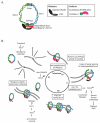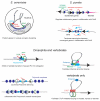The ancient and evolving roles of cohesin in gene expression and DNA repair
- PMID: 22497943
- PMCID: PMC3327610
- DOI: 10.1016/j.cub.2012.02.046
The ancient and evolving roles of cohesin in gene expression and DNA repair
Abstract
The cohesin complex, named for its key role in sister chromatid cohesion, also plays critical roles in gene regulation and DNA repair. It performs all three functions in single cell eukaryotes such as yeasts, and in higher organisms such as man. Minor disruption of cohesin function has significant consequences for human development, even in the absence of measurable effects on chromatid cohesion or chromosome segregation. Here we survey the roles of cohesin in gene regulation and DNA repair, and how these functions vary from yeast to man.
Copyright © 2012 Elsevier Ltd. All rights reserved.
Figures



References
-
- Nasmyth K, Haering CH. Cohesin: its roles and mechanisms. Annu. Rev. Genet. 2009;43:525–558. - PubMed
-
- Ivanov D, Nasmyth K. A topological interaction between cohesin rings and a circular minichromosome. Cell. 2005;122:849–860. - PubMed
-
- Ivanov D, Nasmyth K. A physical assay for sister chromatid cohesion in vitro. Mol. Cell. 2007;27:300–310. - PubMed
-
- Nasmyth K. Cohesin: a catenase with separate entry and exit gates? Nat. Cell Biol. 2011;13:1170–1177. - PubMed
Publication types
MeSH terms
Substances
Grants and funding
LinkOut - more resources
Full Text Sources
Molecular Biology Databases

